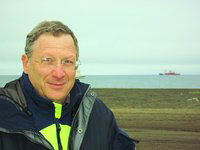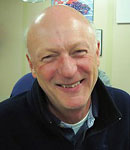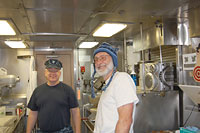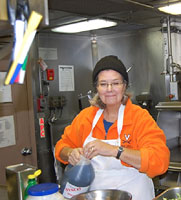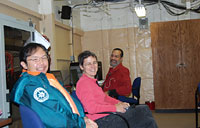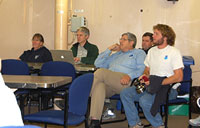

 | |||||||||||||||||||||||
|
|
Journals 2009/2010Jonathan Pazol
August 23, 2009 Happy 50th Anniversary to my parents - sorry I couldn't make it to your party, but I was a little too far to make the trip. Instead, I said "Hello" to a polar bear in your honor. Speaking of parties, I've been getting questions about what and whom I am referring to when I mention the "Science Party" in my journal entries. People want to know who is included and whether or not you can actually have fun on board with a bunch of scientists, so I'll fill in some of the details. There are 32 people who make up the Science Party on this cruise. They are from different organizations, agencies, military branches, and countries (US - including Puerto Rico, Scotland, Canada, Brazil, France, Israel, Russia, and Japan). They have a variety of responsibilities, some of which overlap. Here's a brief description of their positions and the organizations they represent, so that when I refer to them again, their roles will be clearer. Chief Scientists: Larry Mayer - UNH (University of New Hampshire)/CCOM (Center for Coastal and Ocean Mapping) and Andy Armstrong - NOAA (National Oceanographic and Atmospheric Association)/CCOM. Larry and Andy are in charge of the entire expedition. They did the planning and coordinate our activities, as well as those with the crews of the Healy and the scientists aboard the Louis.
Data Processing and GIS (Geographic Information Systems) Team Leaders: Brian Calder - Scientist - CCOM / UNH and Will Fessenden - CCOM. Brian is in charge of coordinating the work of all the data processing teams and making sure that the data analysis methods are consistent and valid. Will is responsible for putting the collected data into a program that can be used by scientists from around the world. Multibeam Processing Team: Nikki Kuenzel - CCOM/UNH, Christina Lacenda - CCOM, and Rachel Soraruf - CCOM/NOAA. This team of graduate students takes the multibeam data, "cleans it up," and gets it ready to be imported into the Fledermaus program. Seismic Processing Team: Kentaro Kenada - Japan Coast Guard, Tom O'Brien - USGS (United States Geologic Survey), Paul Henkart - Scripps Institution of Oceanography, and Jennifer Henderson - NOAA/NGDC (National Geosciences Data Center). This group of people takes the "Chirp" data, analyzes it, and also prepares it for inclusion into Fledermaus. Healy Science Network Team: Dale Chayes - LDEO (Lamont-Doherty Earth Observatory) and Steve Roberts - LDEO/UCAR (United States Center for Atmospheric Research). Dale and Steve have been on the Healy before our part of the expedition and maintain the data-gathering equipment and science network. Geologists: Kelley Brumley - Stanford University graduate student, and Alex Andronikov - University of Michigan associate professor. Kelley and Alex help interpret the sea-floor geology and will be responsible for dredging operations to determine the geological compositions of the areas we are mapping. Ice Team: Pablo Clemente-Colon - NIC (National Ice Center)/NOAA Chief Scientist, Georgette Holmes - NIC, Lt Kyle Obrock and AG1 Steve Lilgreen - NIC/US Navy, and Erin Clark - Canadian Ice Center. This group is responsible for using satellite data and direct observation to measure the extent and characteristics of sea ice and to provide navigational guidance for the Healy crew.
Naval Oceanographic/Weather Team: CDR William Sommer and AG1 Richard Lemkuhl- US Navy. The Weather team does twice daily balloon launches, has deployed a sea glider, engages in various oceanographic projects, and does weather forecasting for various organizations. Other Scientists: Ethan Roth - Scripps Institution of Oceanography - acoustic research; John Hall - Geographic Survey of Israel - scientist; Yoann Ladroit - French graduate student. These people are all working on their own projects and also perform watch duties. Marine Mammal and Community Observers: Justin Pudenz - Contractor - Marine Mammal Observer; George Neakok - Barrow, AK Community Observer. Justin and George watch from the bridge and record marine mammal interactions. Other People: Barbara Hall - US State Department/NOAA - coordinating between different agencies on the expedition; Betsy Baker - Vermont Law School - expert in Law of the Sea; Mike Merchant - Contractor - IT (Information Technology) coordinator; Chris Hedge - NOAA Teacher at Sea - Carmel, IN, and Jon Pazol - ARMADA Teacher - Northlake, IL. Barbara, Betsy, Chris and I are all keeping blogs, each with a different focus. Mike makes sure that our computers, network, and network between the Healy and the Louis all run smoothly.
The group is very diverse, has a variety of unique expertise, and gets along well - very important when you're on a ship and there's nowhere else to go. We meet nightly for science talks but spend our leisure time visiting during meals, working out, watching movies, playing music, reading, and watching the ice go by.
|
||||||||||||||||||||||
